Close encounter with a barred owl
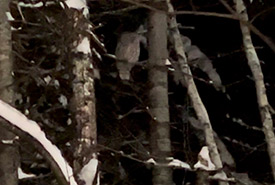
Barred owl at night (Photo by Quincin Chan/NCC staff)
This blog was written by Damien Cheung (with the help of his mom, Quincin Chan). I went to Arrowhead Provincial Park in Ontario for the Fire and Ice Night event with my family on a weekend in January and stayed in a cabin in the park. We had...
Conservation heroes in the county: John Lowry
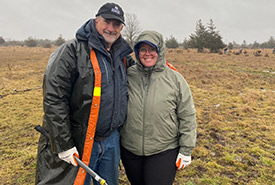
John Lowry and Amanda Tracey at a CV event in Newburgh, Ontario, December 2022 (Photo by Chelsea Marcantonio/NCC staff)
One of my favourite parts of working for the Nature Conservancy of Canada (NCC) is running events — particularly Conservation Volunteers (CV) events. I love meeting new people, learning their stories and what motivates them to come out. I...
Conservation heroes in the county: Richard Bird
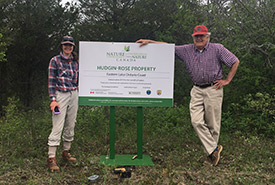
Richard with former NCC staff Ali Giroux installing a property sign at an NCC nature reserve in the county (Photo by Amanda Tracey/NCC staff)
You’ll recall from part one of this series that when I started working for the Nature Conservancy of Canada (NCC), Prince Edward County (the county) quickly stole my heart. From its rich wetlands to its dry grasslands and migratory birds...
Fighting phragmites on Georgian Bay
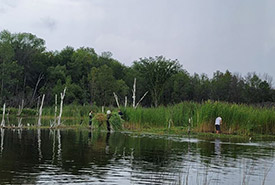
NCC staff and volunteers working to control phragmites on Georgian Bay, ON (Photo by Sara Meyer/NCC staff)
When I started with the Nature Conservancy of Canada (NCC) in the spring of 2022, I had limited knowledge of the invasive species called phragmites (phrag, as many in the conservation circle call it), and also known as common reed, the immense...
Conservation heroes in the county: Cheryl Anderson
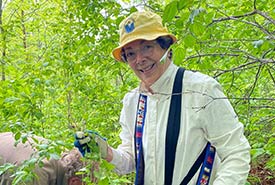
Cheryl Anderson at a garlic mustard pull volunteer event in Prince Edward County, ON (May 2022) (Photo by Amanda Tracey/NCC staff)
I’ve been working for the Nature Conservancy of Canada (NCC) in the eastern part of central Ontario for nearly five years. While my work spans a large geographic area, a lot of my time is spent on the wild south shore of Prince Edward...
1000th balloon in the Grand Bend area
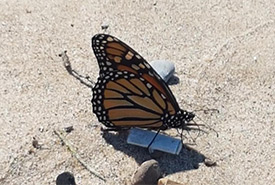
Monarch butterfly perched atop a cigarette butt (Photo by Lynn Tremain)
My name is Lynn Tremain. I live in Grand Bend, Ontario, on the shore of beautiful Lake Huron. I have become a full-fledged plastic/garbage picker. How did this happen? I am not proud to admit that plastic grocery store bags, acquired from online...
Deep in a thousand-hectare woods: Protecting the magic of Happy Valley Forest
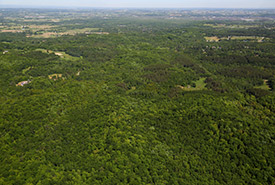
Aerial view of Happy Valley Forest, ON (Photo by Mike Dembeck)
One day it rained red in Happy Valley Forest, and I was there to see it. This was not the red rain of cast-off maple leaves in the fall. This rain painted the tree branches in the spring. And I have witnesses. This is how it went down. It was...
Being happy volunteering in Happy Valley Forest
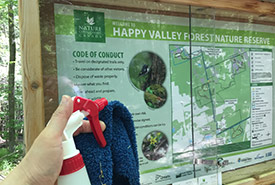
Squeaky clean signboard at Happy Valley Forest (Photo by Yoke Wong)
In April 2019, my Tiles and Trails hiking group leader, Daisy, asked if any members would be interested in doing trail maintenance at a nearby nature reserve. I had done trail cleanups in the past, so trail maintenance was a natural fit. Plus, it...
Recognition and Reconciliation: The pathway forward is Indigenous-led conservation
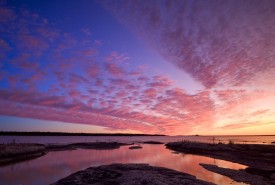
Sunset at Hay Bay, Ontario (Photo by Ethan Meleg)
Friday, September 30 is National Day for Truth and Reconciliation. This day is intended to provide an opportunity for people to recognize and commemorate the legacy of residential schools. This day has also been observed as Orange Shirt Day since...
A prescription for forest health
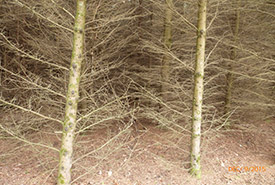
Plantation rows in Southern Norfolk Sand Plain, ON (Photo by NCC)
When you think of a healthy, thriving forest, do you think of a straight lines of trees, all the same size, all the same species? Probably not. While tree plantations can be economically important and can provide significant ecological benefits...

